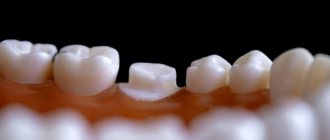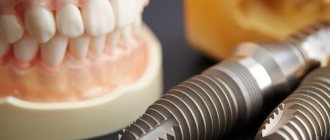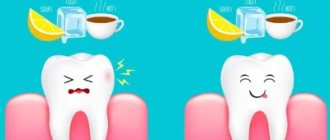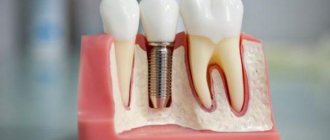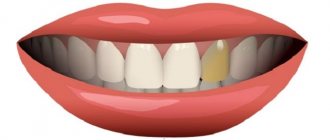Baby teeth begin to emerge from the age of six months. They fully emerge by the age of three, in the amount of 20 pieces. However, after a year or two, the child’s snow-white smile begins to change - temporary molars, incisors and canines are replaced by molars. The process begins when the child is 4 years old and continues for a couple of years.
Why can't a person grow permanent teeth straight away? There are several reasons for this:
- a child’s jaw is not able to accommodate molars at once;
- baby teeth give time to the molars to form;
- The jaw is not fully formed until the age of 18.
Main causes and degrees of mobility
Before considering how to save a loose tooth, it is important to identify the main factor that caused it. Possible reasons include:
- mechanical damage (trauma). As a result of various bruises, damage to the periodontal tissues and root displacement occur. It is worth noting that if the tooth remains in the socket, it is enough to carry out strengthening procedures to save it;
- genetic predisposition. For patients with poor heredity at any age, it is important to take preventive measures to strengthen teeth in order to avoid problems in the future;
- periodontal diseases (for example, gingivitis, periodontal disease). They make the roots weak, causing bleeding and swelling. In the absence of timely treatment, the gums will become loose, which will lead to mobility and loss of teeth;
- bruxism (“teeth grinding”). Very often, bruxism bothers you at night. In such situations, it is recommended to wear special protective equipment during sleep;
- abuse of alcohol and tobacco products. They weaken the body’s protective properties and have a destructive effect on bone tissue, which can lead to instability;
- poor nutrition. People who abuse junk food, neglecting foods with healthy vitamins, minerals and trace elements, often complain of dental problems. In such situations, it is important to start eating a balanced diet and drinking a vitamin complex;
- systemic diseases (osteoporosis, thyroid dysfunction and other abnormalities of the endocrine system). They have a negative impact on the condition of the entire body;
- age. Over the years, due to deterioration of blood supply, bone tissue atrophy gradually occurs, which leads to loose teeth;
- low immunity (for example, due to recent chemotherapy). Since the body lacks the strength to resist, the most vulnerable parts suffer first, the oral cavity being one of them;
- pregnancy and lactation period. The body experiences an acute shortage of microelements and vitamins, and hormonal surges occur. This all affects the condition of the oral cavity;
- uncontrolled use of certain medications.
In this case, four degrees of mobility are distinguished. In the first, the teeth deviate slightly to the side (less than 1 mm). On the second, the amplitude increases (by more than 1 mm). On the third, they deviate in all directions. On the fourth, they are able to rotate around their axis. The answer to the main question: “if a molar tooth is very loose, can it be saved?” positive. But this requires long-term complex treatment.
Importance of baby teeth
After approximately three years, children begin the process of destruction of the root system of baby teeth. This situation leads to their gradual loss. This phenomenon signals the beginning of an important stage in the baby’s development - the growth of molars. However, do not underestimate the importance of baby teeth. It is they who become some kind of “pioneers” and to some extent trample the path for future permanent teeth. Also, the first teeth are active stimulators of jaw bone growth.
The timeliness and sequence of loss of baby teeth is very important. After all, if the first teeth begin to leave the baby’s oral cavity too early, the free space created after their loss will become attractive for neighboring teeth. They will simply begin to grow incorrectly, trying to take over as much of someone else's free space as possible. Such situations lead to malocclusion. Prolonged tooth loss is considered just as undesirable as premature tooth loss. It can also disrupt your bite. That is why the procedure of forced removal of the first teeth is not welcomed by dentists.
Is it possible to save a loose tooth?
If the cause of mobility is pathological processes in the gums (for example, periodontitis, gingivitis), then the doctor determines the infectious or non-infectious etiology, removes plaque and stone, and prescribes a course of therapy. If the cause of unsteadiness is an incorrect bite, they resort to orthodontic treatment (wearing trainers, braces).
Many patients wonder whether a loose molar can be saved with splinting. This is an effective technique that helps strengthen loose teeth by fixing them in one position. It comes in several types:
- extracoronary (the structure is applied and fixed with cement);
- occlusal (involves the use of an overlay or mouth guard);
- intracoronary (includes drilling a hole into which the splinting element is attached).
Most often, during the procedure, the doctor makes a small groove along the dentition into which the splint is placed. It is made of durable fiberglass and is hardly noticeable in the oral cavity. The doctor carefully closes the groove with photopolymer filling material, which allows maintaining aesthetics and functionality.
Splinting is divided into temporary and permanent. Temporary involves fixing structures for a specific period of time so that periodontal tissues have time to recover. The composition of splinting mixtures includes components that allow you to quickly restore stability to the dentition.
What to do after tooth loss
Finally, the tooth gave in and left the gum! But it’s too early to relax - you need to properly treat the wound. A small hole now appears in the place where the tooth was. At first it will bleed, so you need to stop this process:
- rinse your mouth with an antiseptic solution;
- examine the hole from the fallen tooth to make sure that no roots remain there, and the help of a doctor is not required to extract them;
- put a piece of gauze or cotton wool into the wound and bite it to stop the bleeding;
- do not eat food for an hour and give up spicy, salty and sour foods for a while.
If after half an hour the bleeding has not been stopped, and you suspect that part of the tooth remains in the mouth, then seek help from a dentist as soon as possible.
Not all children are able to easily cope with tooth loss. The parents' task is to explain to the child that this is a natural process. A good way to do this is to have a conversation where you can say that tooth loss means growing up. To reinforce a positive attitude towards changing baby teeth, you can exchange lost teeth for nice little things or sweets. Parental support is also important, so under no circumstances should you tease your child with a toothless child.
pixabay.com
A tooth started to loosen: how to save it at home
If a tooth is loose, you can save it at home (as part of complex therapy). In the initial stages, massage of the gums and the area around the loose tooth helps. It is important to perform it systematically (twice a day for 3–4 minutes). Problem areas are massaged in a circular motion without causing excessive stress. After each massage session, it is necessary to rinse your mouth with a decoction of medicinal herbs (for example, chamomile or sea buckthorn).
Also, at home you need to use gels that relieve inflammation and improve blood circulation in tissues (as prescribed by a doctor) and adjust your usual diet (add foods rich in vitamins and minerals).
Results
Based on all of the above, we realized that it is thanks to baby teeth that children develop a correct bite and set the right course for the development of permanent teeth. This fact suggests that there is no need to remove the first teeth in advance. If the tooth begins to loosen on its own, then in this situation you just need to help the baby get rid of it by eating solid food. But you should resort to the help of professionals only when the baby cannot cope with its problem on its own, or when the second one is already pecked under the first tooth.
We should also not forget about the rules of daily oral hygiene and timely visits to the dentist. These two conditions will help keep children's teeth healthy.
Health to you, your children and their teeth!
Advantages of visiting Dr. Martin dentistry
The network of dental clinics "Doctor Martin" was awarded the honorary title of dentistry with European quality of treatment. Despite this, the pricing policy is loyal, the cost of the services provided is affordable, discounts and special offers are regularly held (more details on the price list can be found on the website). Every patient is guaranteed free consultations.
To make an appointment with a specialist, you can contact the administrator at the numbers provided or leave a request on the website. At the initial appointment, the doctor will collect an anamnesis, conduct an examination,, if necessary, prescribe a diagnosis and tell you how to save a loose tooth in a particular case. Thanks to the extensive experience and highly qualified specialists, it is possible to cope with even advanced clinical situations. Don't delay, make an appointment right now!
How does the disease begin?
The causes of loose teeth can be different. Before attempting to cure, it is necessary to find the cause of the pathology.
Most often, pathological tooth mobility occurs with periodontitis and periodontal disease:
- Periodontitis is an inflammatory disease of the periodontal tissues, often a consequence of advanced gingivitis.
- Periodontal disease is a disease that occurs as a result of sclerotic changes in the bone, and a decrease in alveolar septa is also observed. As a result, the necks of the teeth are exposed and over time the teeth begin to loosen.
Loose teeth can be a consequence of diseases such as diabetes, psoriasis, arthritis, as well as diseases of the thyroid gland.
Trauma is another reason that can lead to loose teeth. Their character can be different - from a bruise to a fracture. For any dental injuries, you should consult a doctor for examination and diagnosis.
“A new tooth is shaking” is really not always a reason to panic
During the period of change of bite, which starts at the age of 5–6 years, children's baby teeth begin to loosen. Following this, permanent ones appear who will have to faithfully serve the matured child throughout his life. The process of eruption of molars has its own characteristics.
- First, the dental crown appears, and the root that holds it in the jaw bone remains incompletely formed at this point.
- Therefore, for some time (usually no more than a year), a molar that is not firmly fixed can actually wobble slightly, and then it will strengthen naturally.
By the way, it is useful for adult dental patients to know that normally all permanent teeth have so-called physiological mobility. Our teeth are fixed in the bone alveolus with the help of a ligamentous apparatus, periodontium. Periodontal tissues perform shock-absorbing functions, evenly distributing the mechanical chewing load over the entire dentition and preventing the destruction of individual teeth under the influence of fairly serious chewing pressure. Few non-specialists know that with the help of the chewing muscles, our jaws can develop a force of up to 300–400 kg, depending on the consistency of the chewed products.
But if a mother notices that a child of 8–10 years old has a permanent tooth loose, the mobility is pronounced and accompanied by pain, the gums are swollen, and the child is also capricious and refuses to eat, it is necessary to urgently go for a consultation to pediatric dentistry. It is better to play it safe and exclude pathological mobility in order to prevent the possibility of premature loss of a tooth.
Removal technique
When deciding how to extract a baby tooth, dentists look at the degree of its mobility and location. The intervention is carried out very carefully. This is due to some structural features of children's teeth. For example, they have very thin and very long alveolar walls, and short roots. Therefore, when gripping, it is important not to press too hard to prevent the crown from cracking.
Particular attention is paid to the issue of selection of anesthesia. For severe mobility, a local application is suitable. It involves treating the gums in the area where the affected unit is located. If the loosening is very weak or completely absent, an injection is given to achieve a stronger and more lasting anesthetic effect.
Front
The upper front teeth are very mobile, so they often begin to wobble. To find out the reason for this, a comprehensive examination is carried out, including a panoramic photograph of the oral cavity. What to do if your front molar is loose?
After determining the causes, a complete sanitation of the oral cavity is required to destroy infectious pathogens. If periodontal disease is detected, the specialist performs a special massage on the gums, darsonval procedures. If signs of periodontitis are detected, then be sure to remove stones and plaque, and polish the teeth with an ultrasonic beam. The entire surface of the tooth, including the neck, is polished with a brush using medical varnish containing fluoride.
Difficult deposits are removed with curettes, which pass under the gums, pulling out deposits. Open curettage is also performed, where the gum is cut and then stitched back together. Additionally, medications are prescribed that relieve inflammation with an antiseptic effect.
If the upper front teeth of an adult are seriously damaged or separated, a splint is placed on the upper jaw. A small hole is drilled in the molar into which fiberglass is placed. After which everything is covered with any composite substance that reflects light rays. Thus, during the movement of the front jaw, the molars do not move apart.
In the event of a mechanical injury, when part of the crown is broken and the tooth root is damaged, all fragments are removed and artificial crowns are installed in place of the natural tooth. The sooner a patient contacts a dentist with a problem, the higher the success of treatment. In complex cases, surgery may be required.
Treatment of caries in children - prevention of loose teeth
The enamel of newly erupted permanent teeth is incomplete and continues to form over several years, so it is easily damaged by pathogenic microflora. Even with an almost imperceptible defect on the surface of the tooth, the looser dental tissues located under the layer of hard enamel will be affected very quickly.
The attending physician will assess the degree of destruction of dental tissues and decide on the possibility of treatment. If you do not postpone your visit to the clinic, as a rule, there is no need to resort to tooth extraction in your child. Modern dentistry has effective materials and technologies that allow high-quality restoration of a damaged tooth. In addition to filling with high-quality photocomposites, inserts and crowns are used that retain the ability to fully chew food.
How are gingivitis and periodontitis treated in a child?
Inflammatory diseases of the gum tissue can very quickly lead to loosening of permanent teeth. Therefore, it is so important not to miss the early symptoms of periodontitis in children - first of all, swelling of the gums and the appearance of blood when brushing teeth and eating solid foods.
The main cause of the development of inflammatory diseases is soft plaque, which remains due to poor quality teeth cleaning. Over time, it hardens, forming supra- and subgingival tartar. Hard periodontal deposits first cause inflammation of the mucous membrane, then the process covers periodontal tissue and bone tissue. “Dissolved” tissues no longer fix the permanent tooth, and it becomes loose. If treatment is not started, the child's teeth will fall out.
In some children, periodontitis may be caused by a lack of blood supply to the tissues. This usually occurs in the absence of the necessary chewing load. Parents should ensure that their children eat enough solid vegetables and fruits. In addition, it is necessary to bite and chew food not on one side of the dentition, but on both. In this case, the load on the teeth will be distributed evenly.
Treatment of gums begins with the removal of soft plaque and tartar, for which professional teeth cleaning for children is performed. Anti-inflammatory therapy is then prescribed according to the severity of the disease. In some cases, splinting of teeth is indicated - a procedure that prevents their further loosening. At the clinic, the child will be taught how to brush his teeth correctly, and the parents’ task will be to carefully monitor hygiene procedures at home and, if necessary, brush their son or daughter’s teeth.

